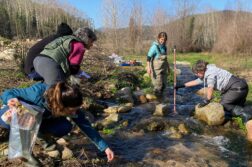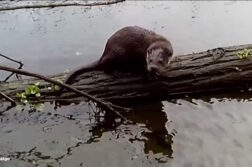Human activities are increasing global emissions of greenhouse gases, such as carbon dioxide (CO2), with dramatic consequences for climate, economy, and human wellbeing. Understanding how ecosystems act as C sources or sinks is essential for mitigating climate change, and for implementing nature conservation strategies and environmental policies. Headwater streams, draining more than 50% of the landscape, are considered control points for CO2 emissions, outgassing about one third of terrestrial primary productivity. However, there are still many unknowns about sources and mechanisms driving CO2 evasion from headwaters and its variability over time and space.
Current theory states that headwaters streams are chimneys of terrestrially-derived CO2, either coming from soil respiration or rock weathering. These lateral inputs are assumed to widely overwhelm CO2 produced by in-stream metabolic processes. However, evidence is growing that the contribution of stream metabolism to CO2 evasion may be higher than initially thought. EVASIONA hypothesizes that CO2 sources (lateral groundwater inputs vs. stream metabolism) are strongly controlled by climate and hydrological processes. We expect large contribution of stream metabolism to CO2 evasion during dry periods when groundwater inputs are small, as typically occurs in water-scarce regions. Furthermore, we expect riparian-stream hydrological processes to control source’s contribution to CO2 evasion by determining not only lateral CO2 inputs, but also the supply of dissolved organic matter (DOC) and dissolved inorganic nitrogen (DIN), two essential resources fueling heterotrophic activity, and thus, in-stream CO2 production.
EVASIONA combines up-to-date modelling and empirical approaches, in situ high-frequency monitoring, microcosm experiments, and smart metabolic tracers to assess spatiotemporal patterns of riparian groundwater inputs, and identify hot spots and hot moments of in-stream CO2 production associated with increases in DOC and DIN availability. EVASIONA will ultimately determine the contribution of lateral groundwater inputs vs. instream sources to CO2 evasion as a function of hydrological and environmental conditions. Our results will help to answer fundamental questions such as: does metabolic activity in headwater streams contribute to CO2 evasion? Does this contribution change over time and space? Which climatic and environmental conditions favor headwater streams to act as CO2 sources or sinks? Our results will help to close catchment C budgets and will contribute to better understand the extent to which headwaters can contribute to climate change mitigation in water-scarce regions.




